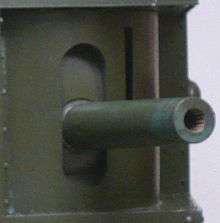QF 6-pounder 6 cwt Hotchkiss
The Ordnance QF 6-pounder 6 cwt Hotchkiss Mk I and Mk II was a shortened version of the original QF 6 pounder Hotchkiss naval gun, and was developed specifically for use in the sponsons of the later Marks of British tanks in World War I, from Mark IV onwards.
| QF 6 pounder 6 cwt Hotchkiss Mk 1 - 2 | |
|---|---|
QF 6 pounder 6 cwt Hotchkiss used for gunnery training. | |
| Type | Tank gun Armoured Train gun |
| Place of origin | United Kingdom |
| Service history | |
| In service | 1917 - 1944 |
| Used by | United Kingdom |
| Wars | World War I World War II |
| Production history | |
| Designer | Hotchkiss |
| Specifications | |
| Barrel length | Bore: 52.12 inch (1.32 m) 23 calibres Total: 60 inch (1.52 m) |
| Shell | Fixed QF, HE (57 x 306R) |
| Calibre | 2.244 in (57 mm) |
| Breech | Vertical sliding block |
| Recoil | Hydro-spring |
| Muzzle velocity | 1,350 ft/s (411 m/s)[1] |
| Effective firing range | 7,300 yards (6,675 m) |
History
World War I

The original QF 6 pounder naval gun had turned out to be too long for practical use with the current British heavy tank designs, which mounted guns in sponsons on the side rather than turrets on top as modern tanks do. The muzzles of the long barrels sometimes dug into the mud or struck obstacles when the vehicle crossed trenches or shell craters. The shortened QF 6 pounder 6 cwt Mk I of single tube construction was introduced in January 1917 in the Mark IV tank, and may be considered the world's first specialised tank gun.
The shortened barrel incurred a reduction in muzzle velocity, but as tank guns in World War I were used against unarmoured or lightly armoured targets such as machine gun nests and artillery pieces at relatively short ranges of a few hundred yards, this was not a major disadvantage.
The Mk II gun was developed at the same time, having a built-up barrel construction.[1]
World War II

The gun was reused in the Second World War, being fitted to the 12 Armoured Trains operated in the United Kingdom. Just as with the tank mounting, the short barrel was an advantage, preventing fouling of line-side structures and bridges. The last British armoured trains (in Scotland) were decommissioned in 1944.
See also
Notes and references
- Hogg & Thurston 1972, Page 39
Bibliography
- I.V. Hogg and L.F. Thurston, British Artillery Weapons & Ammunition 1914-1918. London: Ian Allan, 1972. ISBN 978-0-7110-0381-1